Occupational Environment Monitoring at Projector Manufacturing Factory
99,000 ₫
Note: The above price is calculated per sample and may vary depending on the area of the environment to be monitored and market fluctuations. For more accurate pricing support, please refer to the price list or contact our consulting staff directly.
Monitoring the environment of a projector production factory is a session for collecting, analyzing, and evaluating workplace factors that may be harmful to workers’ health.
Table of Contents
Toggle1. Overview of Projector Manufacturing Factories
a. What is a projector manufacturing factory?
A manufacturing factory for projectors is a facility dedicated to the production and assembly of projector devices. A projector is an electronic device used to project images and videos onto a large surface, typically a screen or other flat surface, for presentations, demonstrations, seminars, teaching, and entertainment purposes.

b. Production stages in a projector manufacturing factory
In a projector manufacturing factory, the main production stages include:
- Research and development: Designing and developing new projector technologies and models, researching and testing features and performance of projectors.
- Component manufacturing: Producing the basic components of projectors, such as bulbs, lenses, circuits, controllers, and other parts.
- Assembly: Combining components and modules to create complete projectors. Assembly steps include installing lenses, control modules, cooling systems, housings, and other components.
- Quality inspection and testing: Testing each projector to ensure quality, performance, and functional compliance. Tests may include image evaluation, brightness, resolution, contrast, and other functionalities.
- Packing and shipping: Packaging projectors in boxes or protective coverings and preparing them for transportation and delivery to customers.

c. Types of machinery used in a projector manufacturing factory
Various machines are used in projector manufacturing to carry out production and assembly processes. Some common machinery includes:
- Metal cutting and processing machines: Machines to cut, shape, and bend metal components for projector parts such as housings, frames, and connectors.
- CNC lathes: Precision lathes for metal components, such as lenses and rotating shafts, to achieve desired dimensions and accuracy.
- Plastic injection machines: Used to produce plastic parts of projectors, such as covers and external components.
- Welding machines: Used to weld metal components together to create a sturdy structure.
- CNC machining centers: Used for precise processing of components such as circuit boards, controllers, and other small parts.
- Quality inspection machines: Used to verify projector performance and quality, including brightness, resolution, contrast, and other features.
- Automated assembly machines: Used to assemble projector components and modules, increasing productivity and ensuring uniformity and accuracy in assembly.
- Printing machines: Used to print labels, charts, and other details on projector parts and packaging.

d. Occupational diseases for workers in projector manufacturing factories
Workers in projector manufacturing may be exposed to certain hazards and risk developing the following occupational diseases:
- Chemical-related illnesses: During projector production, chemicals such as solvents, adhesives, sealants, and flame retardants may be used. Prolonged or improper exposure can affect the respiratory system, skin, eyes, and nervous system.
- Dust-related illnesses: Metal processing and working with other materials can generate metal, plastic, and other dust. Inhalation can cause respiratory problems and lung irritation.
- Noise-related illnesses: Machinery in projector factories may produce high noise levels. Continuous exposure to high noise can cause hearing damage and psychological stress.
- Light-related illnesses: Bright or intense light from projector devices can cause eye strain, glare, and eye issues such as conjunctivitis and cataracts.
- Standing-related illnesses: Jobs in projector manufacturing often require prolonged standing, which can lead to fatigue, back and leg pain, and circulatory issues.
To prevent and reduce the risk of these occupational diseases, projector manufacturing factories should implement labor protection measures such as ensuring the use of personal protective equipment and providing safety training.

e. Popular types of projectors on the market
Currently, there are many types of projectors with different features and technologies. Some popular types include:
- DLP (Digital Light Processing) projectors: Use a DMD (Digital Micromirror Device) chip to create images, offering high brightness, good contrast, and accurate color reproduction.
- LCD (Liquid Crystal Display) projectors: Use liquid crystal layers to display images, providing high resolution, true-to-life colors, and sharp images.
- LED (Light Emitting Diode) projectors: Use LED lights for projection, offering long lifespan, energy efficiency, and fast startup.
- 3D projectors: Enable direct 3D projection without 3D glasses, creating immersive depth effects for presentations, entertainment, and 3D gaming.
- Ultra-short throw projectors: Can project from a short distance, saving space and avoiding obstruction of the light path.
- Portable projectors: Compact and easy to carry, suitable for mobile presentations or small spaces.
- Multifunction projectors: Combine projection with features such as built-in speakers, wireless connectivity, and smart functionalities.

2. Overview of Workplace Environmental Monitoring Services
a. What is workplace environmental monitoring for projector manufacturing factories?
Workplace environmental monitoring (or occupational environment measurement) in a projector manufacturing factory involves collecting, evaluating, and analyzing indicators of workplace environmental factors to implement timely measures, minimize environmental harm to workers’ health, and prevent occupational diseases. Monitoring is legally required for projector manufacturing factories.
Workplace environmental monitoring is crucial for protecting, caring for, and enhancing the health of employees, as they are the main resource of a business and directly contribute to its profit. Employees frequently exposed to hazardous factors beyond permissible limits may suffer health impacts and develop occupational diseases.
REGISTER FOR WORKPLACE ENVIRONMENT MONITORING SERVICE
b. Nam Viet’s workplace environmental monitoring program
Nam Viet’s workplace environmental monitoring program is developed by monitoring engineers specializing in occupational safety and environmental protection. To ensure workers’ health and safety, the program uses modern measurement methods to monitor air, water, and microclimate, physical, and dust-related factors in the workplace. This program is essential for ensuring a safe working environment and protecting employees’ health.
Additionally, the program plays an important role in researching and developing new solutions to improve workplace environmental quality. With the dedication and professionalism of its experts, Nam Viet’s exclusive monitoring program represents a breakthrough in occupational safety and environmental management in Vietnam.

c. Standardization in workplace measurement procedures
Standardization in Nam Viet’s workplace measurement procedures is crucial for ensuring accurate and reliable results. The program applies recognized standards and procedures from the Ho Chi Minh City Department of Health, ensuring that collected data is highly reliable for evaluating workplace environments and making informed decisions to improve occupational health.
These standardized procedures ensure that measurements are performed by highly skilled monitoring specialists with years of experience, allowing managers and experts to trust Nam Viet’s results for accurate, valuable decisions in protecting workers’ health and the environment.
By applying standardized procedures, Nam Viet demonstrates its commitment to ensuring safe workplaces and protecting workers’ health, while contributing positively to improving occupational safety and environmental management in Vietnam.
d. Reporting results of projector manufacturing factory monitoring
Workplace environmental monitoring results are prepared according to Form 04, Appendix III, issued with Decree 44/2016/ND-CP and made in 2 copies: one sent to the contracting workplace and one kept at the monitoring organization.
Records must be kept indefinitely in accordance with legal regulations.

e. Monitoring frequency according to the law
According to Clause 2 of Article 18 of the Occupational Safety and Health Law 84/2015/QH13, employers must monitor workplace environmental factors that are harmful at least once a year.
f. Deadline for submitting monitoring reports according to the law
The report must be submitted before December 31 each year. Enterprises of production facilities are required to submit workplace environmental monitoring results to the Department of Health in the locality where their head office is located and where employees are working.
When there are changes in technology, production processes, or upgrades that may introduce new hazardous factors, enterprises must update occupational hygiene records to reflect harmful factors requiring monitoring.
g. Penalties for violations of workplace environmental monitoring by employers
According to Article 27 of Decree 12/2022/ND-CP dated January 17, 2022, regulating administrative penalties in labor, social insurance, and overseas Vietnamese employees under contract:
- Clause 2: Fines from 2,000,000 – 5,000,000 VND for employers who fail to publicly disclose monitoring results and risk assessment outcomes to employees immediately after obtaining results.
- Clause 3: Fines from 20,000,000 – 40,000,000 VND for employers who do not perform workplace environmental monitoring to control harm to employees’ health as required by law.
- Clause 4: Fines from 40,000,000 – 60,000,000 VND for employers who collude with monitoring organizations to commit fraud in monitoring activities, but not to the level of criminal liability.
3. Harmful Environmental Factors for Workers in Projector Manufacturing Factories
Workers in projector manufacturing factories may be exposed to several harmful environmental factors. The following are potential hazards in the workplace:
- Glare: Projectors use strong light to create images on screens. Continuous exposure to glare can cause eye fatigue, eye strain, and visual disturbances.
- Temperature and humidity: Factories may have high or low temperature and humidity. Extreme temperatures can cause discomfort, fatigue, and affect work performance.
- Dust and chemical fumes: Production may generate dust from materials such as metal, plastic, and chemicals used in processing and assembly. Exposure to dust and chemical fumes can cause respiratory irritation, skin, and eye problems.
- Noise: Machinery and equipment in the factory can produce high noise levels. Continuous exposure to loud noise can damage hearing and cause psychological stress.
- Toxic materials: Some materials used may contain toxic substances like lead, mercury, and organic compounds. Long-term or improper exposure can be harmful to health.
- Electromagnetic agents: Projectors and other electronic devices may emit electromagnetic rays and fields. Continuous exposure can cause stress and affect workers’ health.
REGISTER FOR OCCUPATIONAL ENVIRONMENT MONITORING SERVICE
4. Measures to Improve the Working Environment in Projector Manufacturing Factories
To improve the working environment and protect workers’ health, the following measures can be applied:
- Ensure safe work procedures: Establish clear safety procedures and train workers on safety rules and proper use of machinery and equipment.
- Use protective equipment: Provide and ensure proper use of personal protective equipment such as safety glasses, masks, gloves, noise-canceling headphones, and protective clothing to protect against dust, chemicals, glare, and noise.
- Control dust and chemicals: Implement measures to minimize exposure to dust and chemicals, including dust extraction systems, ventilation, and safe handling procedures.
- Adjust lighting: Ensure projector lighting does not cause glare for workers. Use shields or anti-glare materials to reduce direct light exposure to the eyes.
- Control noise: Apply soundproofing and insulation measures to reduce machinery noise. Provide noise-canceling headphones for workers exposed to high noise levels.
- Periodically conduct occupational environment monitoring in factories to collect and analyze harmful factors, adjusting them to reduce hazards and prevent occupational diseases.
5. Benefits of Regular Monitoring in Projector Manufacturing Factories
An Toan Nam Viet provides enterprises with great benefits when using occupational environment monitoring services in accordance with Decree 44/2016/ND – CP on managing and controlling harmful factors in the workplace affecting workers.
- Enterprises can proactively control harmful factors in workshops or factories.
- Receive advice and recommendations to minimize hazards and improve the workplace environment.
- Indirectly protect human resources, a key factor in business development.
- Reduce the impact of occupational diseases on workers’ health, lowering future treatment costs.
- Improved worker health ensures product quality and maintains production output.
- Ensure compliance with labor safety regulations, avoiding legal risks.
- Enhance credibility and professionalism, elevating the enterprise’s brand.
Nam Viet’s environmental monitoring service is a solution to reduce occupational disease risks, contributing to a clean and high-quality working environment.

6. Nationwide Occupational Environment Monitoring Center
Nam Viet Occupational Environment Monitoring Center is a professional unit specializing in monitoring and measuring occupational environment quality across all provinces in Viet Nam. With a team of experienced monitoring specialists, the center uses modern measurement equipment to ensure accuracy and reliability.
In addition to monitoring services, the center assists clients in planning, handling, and tracking occupational environment issues. Following the motto “customer-centric,” the center prioritizes client satisfaction, meets all client needs, and commits to providing the best solutions for enterprises.
REGISTER FOR OCCUPATIONAL ENVIRONMENT MONITORING SERVICE
With investment in technology, equipment, and personnel, Nam Viet’s monitoring center has become one of the most reputable units in occupational environment monitoring in Ho Chi Minh City, with the following objectives:
- We highly value our brand reputation and service quality.
- We provide clients with the best and most suitable solutions.
- With a team of experienced Masters and Engineers committed to environmental protection and benefiting enterprises.
- Clients using Nam Viet Environmental Monitoring receive professional service from experts along with the best cost advantages.
The occupational environment monitoring process at Nam Viet includes the following steps:
- Before monitoring, we ensure all equipment is calibrated and meets legal requirements.
- Follow the occupational environment monitoring procedures as committed to the Department of Health.
- Accurately report monitoring results to employers.
- If monitoring results indicate unsafe conditions for workers, Nam Viet will assist in corrective measures, and the enterprise will:
- Implement measures to improve working conditions and minimize harmful factor impacts, preventing occupational diseases.
- Organize health check-ups to detect occupational and related diseases early for workers in unsafe environments.
- Provide compensation in kind for workers according to labor law regulations.

7. Occupational Environment Monitoring Price List
To help enterprises conduct professional and effective occupational environment monitoring, Nam Viet provides clients with a detailed price list for monitoring services that is high-quality and reasonably priced.
- Our price list provides detailed information about monitoring service costs, including transportation, measurement, analysis, and report preparation. Clients can trust the accuracy and reliability of our monitoring reports.
- We commit to offering competitive and reasonable prices while providing prompt and professional consultation for any monitoring service inquiries.
- With Nam Viet’s price list, clients can easily select service packages that suit their needs, ensuring maximum satisfaction with professional service quality.
No comments yet

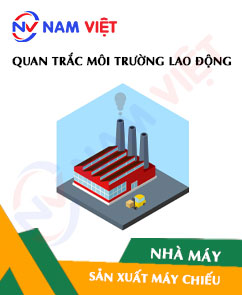
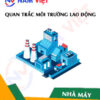
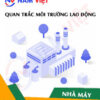
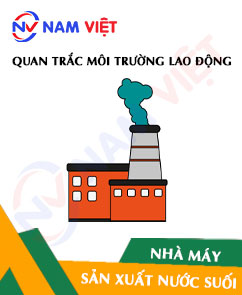
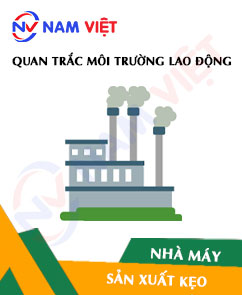
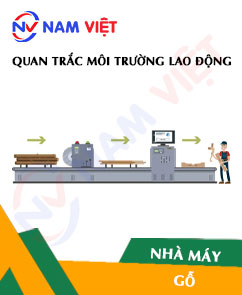
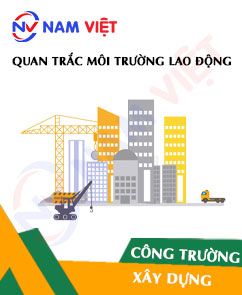
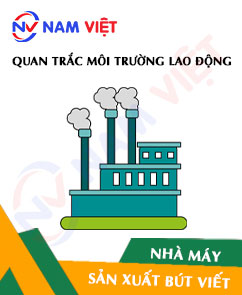



Review Occupational Environment Monitoring at Projector Manufacturing Factory
There are no reviews yet.